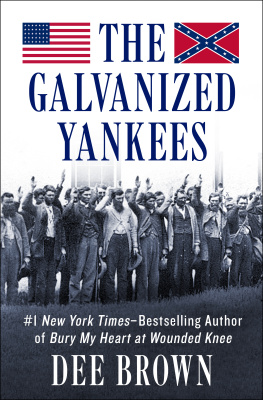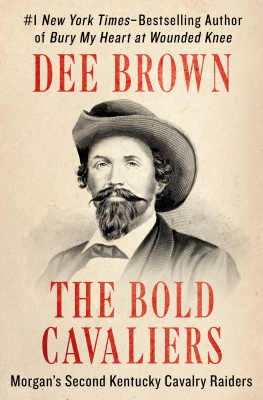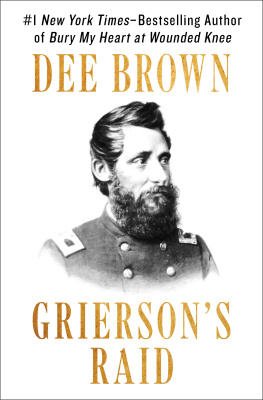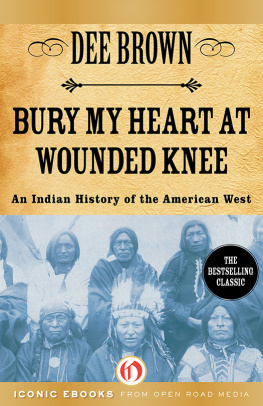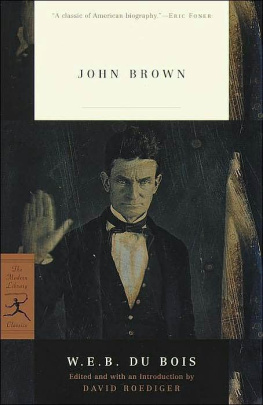
For my friends and former colleagueslibrarians everywhere
Wondrous Times on the Frontier
Dee Brown

Contents
Gambling, Violence, and Merriment
Lawyers, Newsmen, and Other Professionals
Misunderstood Minorities
INTRODUCTION
What This Book Is About
LIFE ON AMERICAS WESTERN FRONTIER was hard, unpleasant most of the time, definitely lacking in almost all amenities or creature comforts. It was dangerous too, not so much from other human beings committing violent acts, but from infectious diseases spread by other human beings. Death by drowning was a common event at unbridged river crossings. And because so many venturers into the frontier equipped themselves with an arsenal of small arms, and handled them carelessly, fatal accidents from these weapons multiplied with each rising wave of immigration. Wagon mishaps, including falls under the wheels and kicks from draft animals, added to the casualties. Hailstorms, tornadoes, blizzards, heat waves, floods, prairie fires, and insect pestilence contributed to the frontier experience.
This grim environment was surely a basic determinant of the humor of Americas westward marching pioneers. The first venturers were often alone in the wilderness, spending much of their time attempting to survive. Some of them knew how to read, but they usually had nothing to read. Probably as an antidote to the harshness and boredom of their lives, they invented the tall tale. Whenever they encountered fellow frontiersmen on the trail or at a fur traders rendezvous, or in a military post or burgeoning settlement, they strove to outdo each other with tall tales, exaggerating real or imaginary incidents into humorous fiction.
Among the practitioners still remembered are Davy Crockett, Jim Bridger, and a collection of fanciful blowhards from the Rockies and Great Plains. They invented big lies that entered the oral tradition of the frontier, eventually being appropriated by the likes of Mark Twain and other creative persons belonging to what we now call the print media. These imaginative writers built on the stories until they became quite elaborate, the best ones eventually entering the literary repository of America.
The lore of the frontier is filled with contradictions that liken it to those great epics of the distant past populated by characters like Eric the Red and El Cid, who were uncertain of the differences between good and evil. For instance, western hospitality and kindness to strangers, especially to those in distress, is one of the most solid of American traditions. Yet at the same time a common stereotype is the frontiersmans demonstrated contempt for a tenderfoot, or newcomer. Let a tenderfoot fall into the hands of a western miner, cowboy, gambler, soldier, or whomever, and he is certain to be tricked and harassed, cheated of his money at cards, fired upon and made to dance, put into the saddle of the wildest bronco, and otherwise physically endangered or harmed.
Elaborate practical jokes and deceptions, frequently aimed at tenderfeet, served to beguile the general public as well. Newspapers and their scribes were among the leading perpetrators, but they also included such salty characters as lawyer Roy Bean, salesman Soapy Smith, boatman Mike Fink, outlaw Black Bart and similar fabricators.
Through the ages, love and romance have always been subjects for satire and bawdy humor. On the frontiera world that within walls of cramped cabins lacked all privacymen and women poked more ribald fun at the difficulties of pairing than any folk since the days of Chaucer or Casanova. Until settlement began, there was always a shortage of white females, thus creating an atmosphere of earthy humor around the white males relations with Indian women.
Many of the comic frontier stories that survive were set in saloons and dance hallscrude situation comedies involving bartenders, cowboys, outlaws, lawmen, gunfighters, entertainers, and prostitutes. The dance hall girls were know by euphemisms such as soiled doves, prairie flowers, scarlet ladies, filles de joie, calico queens, Cyprians, painted beauties, frail sisters, giddy ladies, come-on girls, hurdy girls, and calico cats.
Names of prostitutes were colorful indeed, as court records and newspaper accounts reveal: Little Dot, Hop Fiend Nell, Emporia Belle, Scar-faced Lillie, Miss One Fin, Squirrel Tooth Alice, Ogallala Shorty, Jack-Rabbit Sue, Four-Ace Dora, Kansas Cow, Razorback Jennie, Society Annie, Sallie Purple.
If we may judge by written and printed records, weather on the frontier most of the time seemed like pure hell to the newcomers. At any rate it was a subject of constant comment in letters, diaries, and newspaper columns. Mirages, seldom seen in the East, were quite common in the West before modern-day smog blurred the atmosphere. There is scarcely a diary of a western crossing that does not contain some humorous or wonderstricken reference to incredible visions of wagons rolling upside down in the sky, of silent running buffalo herds, or colorful castles and lakes glittering on the horizon. The pure and transparent atmosphere itself was conducive to awe and hallucinations, one young woman noting that she was so overwhelmed by her first luminous view of the Great Salt Lake Valley that she and her husband temporarily lost their identities until after they came down from the heights.
Almost always on the surface, or just below, frontier humor carried an element of violence. While there were not nearly as many shootouts between bad men and lawmen as our popular culture would have us believe, constant challenges did occur, resulting in black comedy that often involved hangmen and undertakers. Indians and blacks were frequent dupes in these conflicts. If the fracas resulted in bloodshed followed by a hanging, and the person to be hanged was of a minority race or a foreigner, large crowds gathered to observe the proceedings, which usually generated some true gallows humor.
Difficult as frontier travel was, those journeyers lucky enough to possess keen senses of humor managed to endure the experience with considerable lan. Lodgings for stagecoach passengers were so wretched, however, that only the humorous-minded could have borne the overcrowded sleeping places, the grubbiness, the insect pests, and the abominable food and drink. Because of the popularity of published travel accounts in the nineteenth century, a considerable amount of witty literature still survives on these subjects by such famed scribblers as Oscar Wilde, Rudyard Kipling, Henry Morton Stanley, Robert Louis Stevenson, Horace Greeley, and numerous others. A troupe of female correspondentsfrom Europe as well as eastern Americaoutdid their male rivals in recording wry comments about life in the hostelries along the trails and byways of the American West. Although several members of European nobility (including young remittance men) contributed accounts of their travels, they more often than not were also the butts of practical jokes and acerbic quips from chauvinistic American observers of these foreigners outlandish ways.
Methods of travel changed rapidlyfrom Conestoga wagons to stagecoaches and army ambulances, to steamboats and railroadsforcing tellers of funny stories to advance from one mode to the other with successive variations of context. Railroad travel provoked considerably more attempts at caustic humor than did other means of transport, possibly because the early accidents were so horrendous and the discomforts so acute.
Next page

